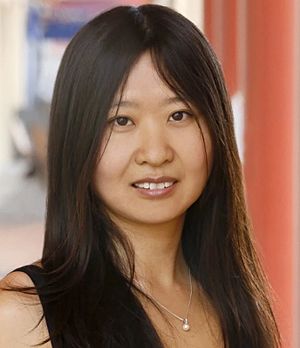Doris Tsao facts for kids
Quick facts for kids
Doris Tsao
|
|
|---|---|
 |
|
| Born |
Changzhou, China
|
| Citizenship | American |
| Alma mater | California Institute of Technology (BS) Harvard University (PhD) |
| Known for | Face perception |
| Awards |
|
| Scientific career | |
| Fields | Neuroscience Visual perception |
| Institutions | University of California, Berkeley |
| Thesis | Stereopsis (2002) |
| Doctoral advisor | Margaret Livingstone |
Doris Ying Tsao is an American neuroscientist and professor of neurobiology and molecular cell biology at the University of California, Berkeley. She was formerly on the faculty at the California Institute of Technology for 12 years. She is recognized for pioneering the use of fMRI with single-unit electrophysiological recordings and for discovering the macaque face patch system for face perception. She is a Howard Hughes Medical Institute Investigator and the director of the T&C Chen Center for Systems Neuroscience. She won a MacArthur "Genius" fellowship in 2018. Tsao was elected a member of the National Academy of Sciences in 2020. In 2024 she was awarded a Kavli Prize in neuroscience along with Nancy Kanwisher and Winrich Freiwald for the discovery and study of specific areas in the brain that perform facial recognition. Also in 2024 she received the Rosenstiel Award. After joining UC Berkeley in 2021, her current research explores visual perception in primates in order to understand how the brain creates our sense of reality.
Early life and education
Tsao was born in Changzhou, China before her family immigrated to the United States when she was four. She grew up in College Park, Maryland and attended Springbrook High School. Her interest in science and in visual neuroscience in particular was inspired by the Feynman Lectures and Kant's Critique of Pure Reason. She completed her B.S. in biology and mathematics in just three years at Caltech in 1996. She then worked with Margaret Livingstone at the Harvard Medical School, where she received her PhD in neuroscience in 2002 and continued to work as a postdoctoral fellow. In 2004 she received the Sofia Kovalevskaya Award from the Humboldt Foundation, which allowed her to start her own independent research group at the University of Bremen in Germany from 2004 to 2008. In 2009 she joined the faculty at Caltech to teach biology, where she also became a Leadership Chair of the Tianqiao and Chrissy Chen Center for Systems Neuroscience. She went on to join the Allen Institute for Brain Science symposium in 2010.
Career and research
As a PhD student working with Margaret Livingstone, Tsao began by studying stereopsis in macaques using single-unit electrophysiological recordings. She then became interested in using fMRI, a technique usually used to visualize the activity of brain areas in humans, to image brain regions in macaques. She collaborated with Roger Tootell to use fMRI to image brain regions involved in depth perception, and then collaborated with Winrich Freiwald, a postdoctoral fellow working with Nancy Kanwisher at MIT, to combine single-unit electrophysiology with fMRI to study face perception in macaques. Similar to the fusiform face area identified in humans with, they discovered a series of small brain areas, referred to as the macaque face patch system, that contain neurons which are selectively activated by faces. Tsao and her lab have continued to make significant advances in understanding the specific facial features that cause neurons in these face patches to be activated. In 2017, her lab "cracked the code" of how our brains recognize faces, identifying the feature dimensions that cause face-selective neurons in different face patches of the IT cortex to respond to faces. Thus, the images of faces presented to the monkeys could be precisely reconstructed from face-selective neurons' activity.
Tsao was named in MIT Technology Review's TR35 list in 2007. She is serving on the Advisory Committee to the NIH Director (BRAIN Initiative Working Group 2.0) established in 2018, the group that advises on allocation of $1.511 billion toward neuroscience research.
See also
- List of neuroscientists
- Margaret Livingstone
- Science (journal)
- MacArthur Fellows Program

